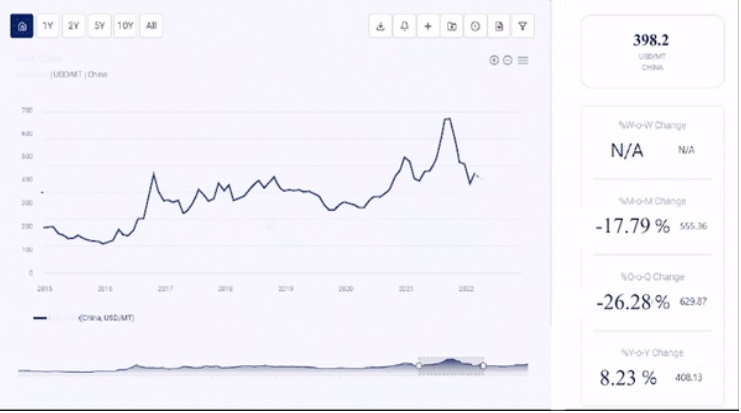Ethylamine, an organic chemical compound, plays a critical role in various industries, including pharmaceuticals, agriculture, chemicals, and rubber. Over recent years, the price trend of ethylamine has become a subject of great interest due to its significant impact on global markets. In this blog, we’ll explore the key factors driving the ethylamine price trends and provide insights into the current and expected future market conditions.
1. Overview of Ethylamine
Ethylamine is a colorless, flammable liquid with a pungent odor, typically produced through the catalytic reaction of ethanol with ammonia. It is widely used in the synthesis of pesticides, surfactants, and dyes, making it a vital intermediate in several industrial applications.
2. Historical Price Trends
In recent years, the price of ethylamine has fluctuated due to a combination of supply-demand dynamics, feedstock costs, and global economic conditions. Key historical factors include:
Request For Sample: https://www.procurementresource.com/resource-center/ethylamine-price-trends/pricerequest
- 2019-2020: Ethylamine prices saw moderate growth as demand from the agrochemical sector, particularly for herbicides and pesticides, increased. Additionally, the pharmaceutical industry’s demand for ethylamine as a precursor for drug development contributed to steady pricing during this period.
- 2020-2021: The COVID-19 pandemic disrupted supply chains globally, leading to sharp fluctuations in raw material prices. As industries experienced shutdowns, the demand for ethylamine dropped temporarily. However, the pharmaceutical industry’s ramp-up during the pandemic mitigated a severe price crash, especially as ethylamine was used in certain COVID-related treatments.
- 2022-2023: Post-pandemic recovery efforts, coupled with rising costs of raw materials like ammonia and ethanol, drove ethylamine prices upward. Furthermore, supply chain disruptions caused by geopolitical tensions, especially in Eastern Europe, affected availability, adding more volatility to the pricing.
3. Key Market Drivers
Several factors have influenced the price of ethylamine in recent years, including:
- Raw Material Costs: The prices of ethanol and ammonia, key raw materials used in the production of ethylamine, play a crucial role in determining its price. Any fluctuations in the availability or pricing of these feedstocks due to geopolitical tensions, energy crises, or trade restrictions significantly affect ethylamine’s market price.
- Global Demand: Ethylamine’s widespread use in various sectors, particularly in the pharmaceutical and agrochemical industries, means that changes in demand from these sectors influence its pricing. Rising global food demand and advancements in drug research and development are leading to greater consumption of ethylamine.
- Supply Chain Disruptions: Recent years have witnessed frequent disruptions in the global supply chain due to factors such as the pandemic, logistical bottlenecks, and natural disasters. These disruptions can lead to sudden shortages, resulting in price hikes.
- Environmental Regulations: Stringent regulations regarding chemical production and emissions are increasingly influencing the ethylamine market. Compliance with environmental standards can raise production costs, which, in turn, affects pricing.
4. Current Price Trends
In 2024, the price of ethylamine continues to reflect the delicate balance between supply and demand. Several key trends are shaping the market:
- Increased Demand from Pharmaceuticals: Ethylamine remains essential for producing various pharmaceutical products, driving demand from developed and developing markets alike. This is expected to support moderate price growth in the near future.
- Raw Material Price Pressure: Ongoing uncertainty in the energy sector, coupled with potential increases in ammonia and ethanol prices, suggests continued upward pressure on ethylamine prices. Companies reliant on these raw materials must stay vigilant regarding potential cost hikes.
- Market Consolidation: Consolidation within the chemical industry is leading to changes in supply chain dynamics. Larger companies have better control over their resources and can negotiate lower prices, potentially stabilizing costs for their end products.
5. Regional Insights
Ethylamine production and consumption patterns vary across regions:
- Asia-Pacific: The Asia-Pacific region, particularly China and India, dominates the ethylamine market. Robust growth in the agricultural and pharmaceutical sectors across these countries has fueled demand, and this trend is expected to continue. However, environmental regulations and energy constraints in China could influence production costs and pricing.
- North America: In the U.S. and Canada, the demand for ethylamine remains strong, especially in the pharmaceutical and agricultural industries. Trade dynamics and domestic production capacities are key factors influencing pricing in this region.
- Europe: Europe’s market is shaped by stringent environmental regulations and growing demand for greener chemical solutions. This focus on sustainability could push prices upward due to increased production costs associated with cleaner technologies.
6. Future Outlook
Looking forward, the ethylamine market is expected to grow, driven by increasing applications in key industries. However, several challenges loom on the horizon:
- Geopolitical Tensions: Continued instability in key resource-producing regions could create further price volatility.
- Sustainability Trends: The push for greener alternatives may influence both production methods and pricing, especially if companies need to invest in costly new technologies.
- Technological Advancements: Advances in chemical engineering may lead to more efficient production methods, potentially offsetting some of the price pressures.
The ethylamine price trend remains influenced by a complex interplay of factors including raw material costs, global demand, and supply chain disruptions. Businesses involved in industries reliant on ethylamine should closely monitor these variables to stay ahead of potential price fluctuations. As we move further into 2024, ethylamine is poised to remain a critical player in the global chemicals market, with prices reflecting ongoing changes in global trade and economic conditions.
Contact Us:
Company Name: Procurement Resource
Contact Person: Endru Smith
Email: [email protected]
Toll-Free Number: USA & Canada - Phone no: +1 307 363 1045 | UK - Phone no: +44 7537 132103 | Asia-Pacific (APAC) - Phone no: +91 1203185500
Address: 30 North Gould Street, Sheridan, WY 82801, USA
